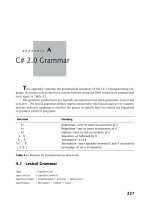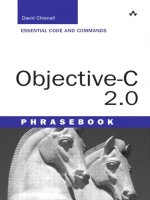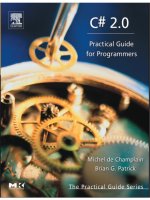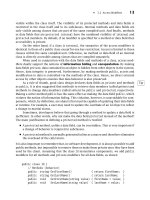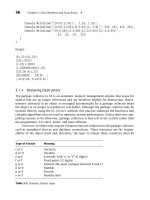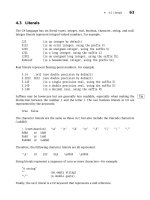Praise for C# 2.0: Practical Guide for Programmers 2005 phần 5 pptx
Bạn đang xem bản rút gọn của tài liệu. Xem và tải ngay bản đầy đủ của tài liệu tại đây (436.12 KB, 26 trang )
■
5.2 Assignment Operators 85
The destination Variable and the source Expression must be type compatible. The
Variable can store either a simple data value or an object reference.
Assignments of Simple Values
Examples:
int a, b, c;
a=1; //OK.
b=a; //OK.
a = c; // Error: Variable must be initialized before used.
1 = a; // Error: Destination must be a variable.
c = (a + b); // OK.
(a + b) = c; // Error: Destination must be a variable.
The assignment operator has the lowest precedence, allowing the expression on the right-
hand side to be evaluated before any assignment:
int a;
a=1;
System.Console.WriteLine(a);
a=a-1; //-hashigher precedence than =
System.Console.WriteLine(a);
a=2+a*3; //(2+(0*3))
System.Console.WriteLine(a);
Output:
1
0
2
Assignments of References
Examples:
Id id1 = new Id("Frank", 1);
Id id2 = new Id("Emma", 2);
id2 = id1;
Copying references by assignment does not copy the content of the source object, only
its reference. Now id2 refers to the same Id object as id1, and the previous object
Id("Emma", 2) is eligible for garbage collection.
86 Chapter 5: Operators, Assignments, and Expressions
■
5.2.2 Multiple Assignments
An assignment always returns the value of the expression on the right-hand side as a result.
Therefore, initializing several variables to a common value or reference using multiple
assignment statements:
int a, b, c;
a=1;b=1;c=1;
can be reduced to a single statement using multiple assignments as shown:
a=b=c=1; //a=(b=(c=1));
The preceding example illustrates the importance of right associativity for the assignment
operator.
5.3 Conditional Operator
The conditional operator evaluates a boolean expression, and, depending on its
resultant value (either true or false), executes one of two expressions as defined here:
EBNF
ConditionalOperator = Condition "?" ExprIfConditionTrue ":" ExprIfConditionFalse.
The conditional operator, therefore, is equivalent to a simple if-else statement:
if ( Condition )
ExprIfConditionTrue
else
ExprIfConditionFalse
For example:
minimum=a<b?a:b;
is equivalent to:
if (a < b)
minimum = a;
else
minimum = b;
Another example:
absolute=a<0?-a:a;
■
5.4 Null Coalescing Operator 87
is equivalent to:
if (a < 0)
absolute = -a;
else
absolute = a;
This operator can be nested but becomes rapidly unreadable:
a?b?c:d:e // Evaluates as (a?(b?c:d):e)
5.4 Null Coalescing Operator
Given that a represents an operand of a nullable or reference type, the null coalescing
operator is defined as in Table 5.2.
Name Notation Meaning
Null Coalescing a??b Returns a if a is non-null, otherwise returns b.
Table 5.2: Null coalescing operator.
Example:
using System;
public class CoalescingNull {
public static void Main(string[] args) {
bool? a = true;
bool? b = false;
object o = null;
Console.WriteLine("|{0,4}|{1,4}|{2,4}|{3,4}|",
a??b, a??o, o??b, o??o );
}
}
Output:
|True|True|False| |
88 Chapter 5: Operators, Assignments, and Expressions
■
5.5 Conditional Logical Operators
Given that a and b represent boolean expressions, the conditional logical operators are
defined as in Table 5.3.
Name Notation Meaning
Conditional Logical AND a && b true if both operands are true, otherwise false
Conditional Logical OR a || b true if either or both operands are true,
otherwise false
Conditional Logical NOT !a true if the operand is false, otherwise false
Table 5.3: Conditional logical operators.
These operators are much like logical (bitwise) operators except that their evaluation
is short-circuited. The short-circuit eliminates unnecessary evaluations. If the value of
a is false then the expression a&&balso evaluates to false without the need to
evaluate b. Similarly, if the value of a is true then the expression a||balso evaluates
to true without the need to evaluate b. Table 5.4 summarizes all combinations of boolean
values.
a b a&&b a||b
true true true true
true false false true
false true false true
false false false false
Table 5.4: Values for conditional logical operators.
Example:
using System;
public class ConditionalLogical {
public static void Main(string[] args) {
bool t, b, f = false;
t=b=true;
Console.WriteLine( (t && t) +" "+ (t && f) +" "+ (f && t) +" "+
(f && f) );
Console.WriteLine( (t || t) +" "+ (t || f) +" "+ (f || t) +" "+
(f || f) );
■
5.6 Logical Operators 89
// t&&b where f not evaluated (short-circuited)
Console.Write("{0} ", t&&b || f );
// f || b where t not evaluated (short-circuited)
Console.Write("{0} ", f&&t || b );
// f || f where b not evaluated (short-circuited)
Console.Write("{0} ", f || f&&b );
// t&&b where f not evaluated (short-circuited)
Console.WriteLine("{0}", f || t&&b );
}
}
Output:
True False False False
True True True False
True True False True
5.6 Logical Operators
Given that a and b are corresponding bit values in the left-hand and right-hand operands,
respectively, the logical (bitwise) operators are defined as in Table 5.5.
Name Notation Meaning
Logical NOT ˜a Invert the bit value (Complement)
Logical AND a&b 1 if both bits are 1, otherwise 0
Logical OR a|b 1 if either or both bits are 1, otherwise 0
Logical XOR aˆb 1 if and only if one of the bits is 1, otherwise 0
Table 5.5: Logical operators.
a b ˜a a&b a|b aˆb
11 0 1 1 0
10 0 0 1 1
01 1 0 1 1
001000
Table 5.6: Values for logical operators.
90 Chapter 5: Operators, Assignments, and Expressions
■
Valid types for logical operators are integers and boolean.
Example:
public class LogicalBitwise {
public static void Main(string[] args) {
ushort a = 0x005A; // in binary = 0000 0000 0101 1010
ushort b = 0x3C5A; // in binary = 0011 1100 0101 1010
System.Console.WriteLine( "{0:x}", a&b);
System.Console.WriteLine( "{0:x}", a|b);
System.Console.WriteLine( "{0:x}", aˆb);
System.Console.WriteLine( "{0:x}", ˜a );
System.Console.WriteLine( "{0:x}", ˜b );
}
}
Output:
5a
3c5a
3c00
ffffffa5
ffffc3a5
5.6.1 Logical Operators as Conditional Logical Operators
The logical bitwise operators may also be used as conditional logical operators since they
can be applied to boolean operands and return a bool value. Given that a and b represent
boolean expressions, the logical operators are defined as in Table 5.7.
Name Notation Meaning
Logical NOT !a Returns the complement of the truth value of a (negation)
Logical AND a & b true if both operands are true, otherwise false
Logical OR a | b true if either or both operands are true, otherwise false
Logical XOR a ˆ b true if and only if one operand is true, otherwise false
Table 5.7: Logical operators as conditional logical operators.
Note that the logical operators & and | have the same truth values as their corresponding
conditional operators, && and || (Table 5.8).
■
5.6 Logical Operators 91
a b !a a&b a|b aˆb
true true false true true false
true false false false true true
false true true false true true
false false true false false false
Table 5.8: Values for logical operators.
5.6.2 Compound Logical Assignment Operators
Given that a and b represent integral expressions, the compound logical assignment
operators are defined as in Table 5.9.
Name Notation Meaning
Compound Logical AND b &= a b = (Type) (b & (a))
Compound Logical OR b |= a b = (Type) (b | (a))
Compound Logical XOR b ˆ= a b = (Type) (b ˆ (a))
Table 5.9: Compound logical assignment operators.
Based on the preceding table, a and b are first promoted to int and the result is implicitly
narrowed to the destination (Type)ofb upon assignment:
byte b = 0x62; // 0x62
b &= 0x0F; // 0x62 & 0x0F => 0x00000002 (now an int)
// 0x02 (cast back to a byte)
Example:
using System;
public class CompoundLogical {
public static void Main(string[] args) {
bool t, b, f = false;
t=b=true;
Console.WriteLine( (t & t) +" "+ (t & f) +" "+ (f & t) +" "+
(f&f));
Console.WriteLine( (t | t) +" "+ (t | f) +" "+ (f | t) +" "+
(f|f));
92 Chapter 5: Operators, Assignments, and Expressions
■
// t&b where f not evaluated (short-circuited)
Console.Write("{0} ", t&b | f);
// f | b where t not evaluated (short-circuited)
Console.Write("{0} ", f&t | b);
//f|f where b not evaluated (short-circuited)
Console.Write("{0} ", f | f&b);
// t&b where f not evaluated (short-circuited)
Console.Write("{0} ", f | t&b);
Console.Write("{0} ", f &= t | t); // (1) f=(f&(t|t))
Console.WriteLine("{0}",f=f&t|t);//(2)f=((f&t)|t)
}
}
Output:
True False False False
True True True False
True True False True False True
Note that assignments (1) and (2) give different results for the same value of the operands.
5.7 Equality Operators
5.7.1 Simple Value Type Equality
Given that a and b represent operands of simple value types, the simple-type equality
operators are defined as in Table 5.10.
Name Notation Meaning
Equal a == b true if a and b have the same simple value, otherwise false
Not Equal a != b true if a and b have different simple values, otherwise false
Table 5.10: Simple value type equality operators.
Example:
public class Equality {
public static void Main(string[] args) {
System.Console.WriteLine( 9 == 9 );
System.Console.WriteLine( 0 != 1 );
■
5.7 Equality Operators 93
System.Console.WriteLine( ‘9’ == 9 ); // Operands are promoted
// as ints.
System.Console.WriteLine( ‘0’ == 0x30 ); // Operands are promoted
// as ints.
}
}
Output:
True
True
False
True
When comparing floating-point numbers, bear in mind that values are approximated to a
finite number of bits.
5.7.2 Object Reference and Value Equality
The predefined reference-type equality operators == and != accept operands of type
object. Testing two object references o1 and o2 using Object.ReferenceEquals(o1, o2)
is equivalent to:
(object)o1 == (object)o2
Examples:
bool b;
Name m1 = new Name("Michel");
Name m2 = new Name("Michel");
string m3 = "Michel";
b = m2 == m3; // Compile-time error (incompatible type).
b = m1 == m2; // False (two different objects).
m1 = m2; // Alias to the same object m2.
b = m1 == m2; // True (same reference).
The null reference can be assigned and compared to any object reference. The
Object.Equals method also returns true only if the object is compared to itself:
class Object {
bool Equals(Object o) { return o == this; }
}
However, it is common practice to overload the equality operators and to override the
Tip
Equals method in derived classes to provide object value rather than object reference
equality as shown in Section 4.6.
94 Chapter 5: Operators, Assignments, and Expressions
■
5.8 Relational Operators
Given that a and b represent numeric expressions, the relational operators are defined
as in Table 5.11.
Name Notation Meaning
Less Than a < b true if a is less than b, otherwise false
Less Than or Equal a <= b true if a is less than or equal to b,
otherwise false
Greater Than a > b true if a is greater than b, otherwise false
Greater Than or Equal a >= b true if a is greater than or equal to b,
otherwise false
Table 5.11: Relational operators.
All relational operators are binary operators and all operands are promoted, if necessary,
to numeric values. The evaluation results in a boolean value. Relational operators have a
lower precedence than arithmetic operators, but a higher precedence than the assignment
operators.
Example:
public class Relational {
public static void Main(string[] args) {
System.Console.WriteLine( 1 < 2 );
System.Console.WriteLine( 3 <= 4 );
System.Console.WriteLine( 5 > 6 );
System.Console.WriteLine( 7 >= 8 );
System.Console.WriteLine( 5.5 >= 5.0 );
System.Console.WriteLine( ‘A’ < ‘a’ ); // Operands are promoted
// as ints.
}
}
Output:
True
True
False
False
True
True
■
5.8 Relational Operators 95
5.8.1 Type Testing
Two additional operators in C# are used for type testing: is and as. The is operator defined
next returns a boolean value and is used to determine at runtime if an object is an instance
of Type or any type compatible with (derived from) Type.
EBNF
IsOperator = Expression "is" Type .
If the result of the is operator is true then Expression can be successfully converted
to Type via explicit reference casting or implicit boxing/unboxing. In other words, the
is operator verifies if an object is compatible with another instance of any derived class
within the same hierarchy of classes. If the Expression is null, then the result is false.
The following example illustrates implicit unboxing on line 6 and the need to explicitly
cast on line 8 in order to invoke the specific ToUpper method of the string class:
1 using System;
2
3 public class TestIs {
4 private static void PrintValue(object o) {
5 if (o is Int32)
6 Console.WriteLine("Integer value in hexadecimal = {0:X}", o);
7 if (o is string)
8 Console.WriteLine("String value in upper case = {0}",
9 ((string)o).ToUpper());
10 }
11 public static void Main(string[] args) {
12 PrintValue(10);
13 PrintValue("Michel");
14 }
15 }
Output:
Integer value in hexadecimal = A
String value in upper case = MICHEL
The as operator defined next is a conditional type conversion. It attempts to perform
a downcast on the result of an expression and if unsuccessful, returns a null value. If
only an explicit cast is performed on the expression using the () operator, an unsuccess-
ful cast will raise an InvalidCastException. The as operator, therefore, is used to avoid
this situation by returning a null value rather than risk a possible termination of the
application.
EBNF
AsOperator = Expression "as" Type .
96 Chapter 5: Operators, Assignments, and Expressions
■
The preceding definition is equivalent to the following ternary condition:
Expression is Type ? (Type) Expression : (Type) null
Example:
public class TypeTesting {
public static void Main(string[] args) {
object o = "Michel";
char[]c=oaschar[]; // c = (char[])null
strings=oasstring; // s = (string)o
System.Console.WriteLine( "{0}", c == null );
System.Console.WriteLine( "{0}", s.Equals("Michel") );
}
}
Output:
True
True
The as operator cannot be applied to value types.
5.9 Shift Operators
Given that a contains the value whose bits are to be shifted and n is the number of times
to shift, the shift operators are defined as in Table 5.12.
Name Notation Meaning
Shift left a<<n Shift all bits to the left n times, filling with 0 from the right.
Shift right a>>n Shift all bits to the right n times, filling with sign bit from the left.
Table 5.12: Shift operators.
Note that a is either int, uint, long,orulong and that n is always an int type. Since char,
byte, and short operands are promoted to either int or long, the result of applying these
shift operators is always either an int or a long value.
■
5.10 Arithmetic Operators 97
5.9.1 Compound Shift Assignment Operators
Given that a and b represent integral operands, the compound shift assignment
operators are defined as in Table 5.13.
Name Notation Meaning
Compound Shift Assignment Left (sign fill) b <<= a b = (Type) (b << (a))
Compound Shift Assignment Right (sign fill) b >>= a b = (Type) (b >> (a))
Table 5.13: Compound shift assignment operators.
Example:
public class Shift {
public static void Main(string[] args) {
byte a = 0x06; // In binary = 0000 0110
byte b = 0x06; // In binary = 0000 0110
System.Console.WriteLine("{0:x}", (a >> 1) | (b << 1) );
System.Console.WriteLine("{0:x}({1})", (-a >> 2), (-a >> 2) );
System.Console.WriteLine("{0:x}({1})", (-a << 2), (-a << 2) );
}
}
Output:
f
fffffffe(-2)
ffffffe8(-24)
5.10 Arithmetic Operators
5.10.1 Multiplicative Operators
Given that a and b represent operands of numeric data types, the multiplicative
operators are defined as in Table 5.14.
Name Notation Meaning
Multiplication a*b amultiplied by b
Division a/b adivided by b
Modulus a%b amod b
Table 5.14: Binary multiplicative operators.
98 Chapter 5: Operators, Assignments, and Expressions
■
If either a or b is a floating-point value, then the result of a multiplication or division is a
floating-point value as well. If a and b are integral values, then the result of a multiplication
or division is also integral (and truncated if necessary). The modulus operator returns the
remainder of a division performed on either floating-point or integral operands.
Examples:
13 % 5 // 3
11.5 % 2.5 // 1.5
10 / 0 // DivideByZeroException
4.0 / 5 // 0.8
4.0 / 0.0 // Infinity (positive infinity)
-4.0 / 0.0 // -Infinity (negative infinity)
0.0 / 0.0 // NaN (not-a-number)
Because C# uses the IEEE 754 formats for floating-point types, dividing a non-zero number
by zero generates Infinity or -Infinity as a result. Similarly, dividing zero by zero
generates NaN as a result.
5.10.2 Additive Operators
Given that a and b represent operands of numeric data types, the additive operators are
defined as in Table 5.15.
Name Notation Meaning
Addition a+b ais added to b
Subtraction a-b bis subtracted from a
Table 5.15: Binary additive operators.
If either a or b is a floating-point value, then the result of an addition or subtraction is a
floating-point value as well. If a and b are integral values, then the result of an addition or
subtraction is also integral.
Examples:
13 + 5 // 18
13.0 + 5 // 18.0
13 - 5 // 8
11.5 - 2.5 // 9.0
The binary operator + also acts as a string concatenation if one or both of the operands is
a string object. If only one of the operands is a string, the other is implicitly converted to
its string representation method before the concatenation is performed. For non-string
■
5.10 Arithmetic Operators 99
objects, this conversion is performed using the ToString method. The result of the con-
catenation is always a new string object.
For example:
"1+1isnotequal to"+1+1
is evaluated as:
((("1+1isnotequal to ") + 1) + 1)
and results in the following string:
"1+1isnotequal to 11"
5.10.3 checked/unchecked Operators
The result of an arithmetic expression that falls outside the limits or range of an integral
destination variable generates an overflow error.InC#, these errors can be checked or
disabled at compile-time or runtime, and at the level of expressions, blocks, or the entire
source file.
Checking for overflow at compile-time is limited to constant expressions. In the fol-
lowing example, the constant expression MAX+1 exceeds the range of sbyte (−128 +127)
and is therefore not assignable to i. Hence, a compilation error is generated.
class Index {
private sbyte i;
private const sbyte MAX = 127;
public Index(){i=MAX+1; } // Compile error: Constant value ‘128’
// cannot be converted to a ‘sbyte’.
}
Checking for overflow at runtime is achieved at the level of the entire source file using the
compiler option /checked. This option, however, is turned off by default (i.e., /checked-).
Therefore, when the following source file called TestChecked.cs is compiled without the
/checked option:
class Index {
private sbyte i;
private const sbyte MAX = 127;
public Index() { i = MAX; }
public sbyte I() { return ++i; }
public static void Main() {
System.Console.WriteLine("{0}", new Index().I());
}
}
100 Chapter 5: Operators, Assignments, and Expressions
■
it is equivalent to explicitly turning off all overflow checking:
csc /checked- TestChecked.cs
Running this program will (incorrectly) output -128. On the other hand, if the source file
is recompiled by turning on all overflow checking with the /checked+ option, then the
program throws a System.OverflowException.
Overflow can also be checked at a finer granularity using the operators checked and
unchecked. Even though these operators are part of the primary category, it is appro-
priate to discuss them at this point since they are related to arithmetic operations on
integral types. The checked and unchecked operators, applied to either expressions or
block statements, have the following syntax:
EBNF
CheckedExpr = "checked" "(" expression ")" .
CheckedStmt = "checked" "{" statement+ "}" .
UncheckedExpr = "unchecked" "(" expression ")" .
UncheckedStmt = "unchecked" "{" statement+ "}" .
Instead of compiling a source file with the checked option on, overflow checking can be
limited to particular expressions with the compiler option disabled. Using the preceding
example, only the expression ++i may be checked for overflow within the I method:
{ return checked(++i); }
Although the compiler option checked is turned off, a System.OverflowException is still
generated. Likewise, if the source file is compiled with the checked option turned on, then
in order to avoid the exception, overflow checking for the expression ++i can be disabled
as follows:
{ return unchecked(++i); }
If several statements within a method are to be checked/unchecked for overflow, then
the checked or unchecked operator can be applied to a block of statements as shown
here:
public sbyte I() {
unchecked {
// Other statements
return ++i;
}
}
5.10.4 Compound Arithmetic Assignment Operators
The compound arithmetic assignment operator has the following syntax:EBNF
Variable Op"=" Expression .
■
5.11 Unary Operators 101
and the following meaning:
Variable "=" "(" Type ")" "(" Variable Op "(" Expression ")" ")" .
Given that v and e represent a variable and expression of a numeric data type, the
compound arithmetic assignment operators are defined as in Table 5.16.
Name Notation Meaning
Multiplication Assignment v *= e v = (T) (v*(e))
Division Assignment v /= e v = (T) (v/(e))
Modulus Assignment v %= e v = (T) (v%(e))
Addition Assignment v += e v = (T) (v+(e))
Subtraction Assignment v -= e v = (T) (v-(e))
Table 5.16: Compound arithmetic assignment operators.
An implied type cast (T) in compound assignments is necessary.
Examples:
inti=2;
i*=i+4; //i=(int) (i * (i + 4))
byteb=2;
b += 10; // b = (byte) ((int)b + 10)
b=b+10; //Error: explicit cast required.
5.11 Unary Operators
Given that a represents an operand of a numeric data type, the unary operators are
defined as in Table 5.17.
Name Notation Meaning
Unary Plus +a a remains unchanged
Unary Minus -a a is negated
Table 5.17: Unary arithmetic operators.
The associativity of the unary operators is from right to left:
int value = - -10; // (-(-10))
102 Chapter 5: Operators, Assignments, and Expressions
■
Notice that the blank is needed to separate the unary operators. Otherwise, the expression
would be interpreted as the decrement operator
Both logical unary operators, ! (boolean NOT) and ˜ (bitwise NOT), have already been
presented in Sections 5.5 and 5.6, respectively.
5.11.1 Prefix and Postfix Operators
The increment (++) and decrement ( ) operators come in two flavors: prefix and postfix.
In the prefix case, the increment or decrement operator is placed before a simple data type
variable. For example:
++a //a=a+1
In the postfix case, the increment or decrement operator is placed after a simple data type
variable. For example:
a //a=a-1
These operators have the side effect of changing the value of a simple data type variable by
plus one for an increment and minus one for a decrement. The prefix operator increments
or decrements the simple data type variable before the expression in which it appears is
evaluated. The postfix operator increments or decrements the simple data type variable
after the expression in which it appears is evaluated.
Consider the following sequence of instructions and the resultant values for a and b
after each instruction is executed:
intb=6;
int a = ++b;
//a=7,b=7
a = b++;
//a=7,b=8
++b;
//a=7,b=9
a = b;
//a=8,b=8
a = b ;
//a=8,b=7
These operators are very useful for updating variables in loops where only the side-
effect of the operator is of interest. Even if both are considered unary operators, postfix
operators are in the primary category and therefore evaluated before the prefix opera-
tors. The following example illustrates the precedence of the ++ postfix operator over its
prefix one:
class TestPrePost {
public static void Main() {
■
5.12 Other Primary Operators 103
int a, b;
a=b=1;
System.Console.Write("{0} ", a++ + ++b); //1+2=3
a=b=1;
System.Console.Write("{0} ", a++ + b++); //1+1=2
a=b=1;
System.Console.Write("{0} ", ++a + b++); //2+1=3
a=b=1;
System.Console.Write("{0} ", ++a + ++b); //2+2=4
a=1;
System.Console.Write("{0} ", a++ + ++a); //1+3=4
a=1;
System.Console.WriteLine("{0} ", ++a + a++); //3+1=4
}
}
Output:
323444
5.11.2 Explicit Casts
C# is a strongly typed language and therefore checks for type compatibility at compile-
time. As seen in Section 5.8.1, some checks are only possible at runtime using the is and as
operators. An operator, however, can have incompatible operands, for example, assigning
a char to a byte. In that case, a cast must be used to explicitly indicate the type conversion
as follows:
EBNF
CastExpr = "(" Type ")" Expression .
At runtime, a cast applied to either a simple value or a reference results in a new value of
Type and is called an explicit cast (or conversion). For example:
byte b = 0x34;
char c = (char)b; // c = 0x0034 or ‘4’
b = (byte)c; // b = 0x34;
It is worth noting again that if types are not compatible at runtime, then an
InvalidCastException is thrown.
5.12 Other Primary Operators
The []notation is used to declare and construct arrays and to access array elements. The
x.y, f(x), and (x) notations are used to access members, to invoke methods, and to pass
104 Chapter 5: Operators, Assignments, and Expressions
■
arguments, respectively. All these operators, including the new operator to create objects,
have been covered in Chapter 3.
The typeof operator defined next returns the System.Type object for a class. This
object contains information about all members of the given class.
EBNF
TypeofExpr = "typeof" "(" Type ")" .
The same object can also be obtained by calling GetType with any instance of the class.
Hence, Type t = typeof(Id); is equivalent to:
Id id = new Id();
Type t = id.GetType();
As a final note, the typeof operator is particularly useful when an instance of the type is
not available to invoke GetType.
5.13 Overloadable Operators
Overloading an operator in C# allows us to define an operator in the context of a new type.
This feature is very similar to the one in C++. However, not all operators can be over-
loaded including member access (x.y), method invocation (f(x)), array indexing (a[x]), or
the =, &&, ||, ?:, checked, unchecked, new, typeof, as, and is operators. Overloading an
operator, however, should only be done when the meaning is clear from its context. Some
Tip
excellent candidates for operator overloading are == (equal), != (not equal), + (addition),
and - (subtraction).
In Section 4.6, the Equals method for the Counter class was reimplemented to be
used in the following manner:
Counter c1 = new Counter();
Counter c2 = new Counter();
bool result = c1.Equals(c2);
The operator == can also be overloaded for our Counter class in order to compare two
counters more succinctly as:
bool result = c1 == c2;
The implementation of overloaded operators as shown next for == and != is defined by a
method called operator followed by the operator itself. Here, two parameters are passed
that correspond to the two operands.
class Counter {
public static bool operator ==(Counter left, Counter right) {
// Check if left and right refer to the same object
// or are both null.
■
Exercises 105
if (Object.ReferenceEquals(left, right))
return true;
// Check if one of them is null.
if (Object.ReferenceEquals(left, null) ||
Object.ReferenceEquals(right, null))
return false;
return left.Equals(right);
}
public static bool operator !=(Counter left, Counter right) {
return !(left == right);
}
}
In this case, the Equals method (and the operator ==) are reused.
Table 5.18 illustrates the relationship between operator and method notations for
unary and binary operators. In this table, op denotes any overloadable operator. A unary
operator has only a single operand, and a binary operator has both left and right operands.
An operator cannot be redefined if it has the same signature as a predefined operator in
C#.
Overloadable Operator Notation Method Notation
Unary operator op operand operator op (operand)
Unary postfix (++ and ) operand op operator op (operand)
Binary operator left op right operator op (left, right)
Table 5.18: Method notations for overloadable operators.
Exercises
Exercise 5-1. Improve class Id by adding the overloaded operators == and !=.
Exercise 5-2. Write similar TypeTesting classes that create Person and Id objects and
pass them as parameters to a static method Print(Id id) in order to identify objects at
runtime using type-testing operators.
chapter 6
Statements and Exceptions
In C#, statements fall into one of three categories: labeled, declaration, and
embedded. This is shown by the following EBNF definition:
EBNF
Stmt = LabeledStmt | DeclStmt | EmbeddedStmt .
Embedded statements include the full gamut of conditional, iterative, and transfer state-
ments that one would expect in any high-level language. Additional constructs for mutual
exclusion and the use of resources are also provided.
In this chapter, we first present one type of embedded statement called the block
statement. Declaration statements and all other embedded statements are then discussed
with particular emphasis on the exception-handling mechanism of C#. Because of their
limited use and appeal, labeled statements are only described in the narrow context of the
goto and switch statements.
6.1 Block Statement
A block is an embedded statement that encloses zero or more statements within a pair of
opening and closing braces:
EBNF
Block = "{" Stmts? "}" .
Each statement in a block is executed in sequence, but the block itself returns no value.
Although a block is not required for only one statement, it is a useful practice to enclose
Tip
a single statement within braces, as would become required if additional statements were
added. For example, if a debugging Write is added to this statement:
if(x>0)
x = temp;
107
108 Chapter 6: Statements and Exceptions
■
then braces are required to enclose the two statements as a single block:
if(x>0){
x = temp;
Console.Write("Value of x is {0}.", x);
}
Finally, if code is not reachable within a block, then a compilation error is generated.
6.2 Declaration Statements
A declaration statement declares and initializes one or more local variables or constants
of a given type. In the case of a constant, the type must be preceded by the keyword
const and the initialization must be explicit. Variables need not be explicitly initialized
upon declaration since number, character, and reference-type variables are initialized by
default to 0, ‘\0’, and null, respectively. The complete EBNF definition for declaration
statements is given here:
EBNF
DeclStmt = ( LocalVariableDecl | LocalConstantDecl ) ";" .
LocalVariableDecl = Type LocalVariableDecltorList .
LocalVariableDecltor = Identifier ( "=" LocalVariableInitializer )? .
LocalVariableInitializer = Expr | ArrayInitializer .
LocalConstantDecl = "const" Type ConstantDecltorList .
ConstantDecltor = Identifier "=" ConstantExpr .
For example:
float number;
const String name = "Michel";
intn=2,m;
int len[]={1,n,3};
A variable declaration can appear anywhere in a block, and not just at the beginning as in
C. The scope of the variable, however, ranges from its point of declaration to the end of
the innermost block in which it is declared. For example:
{
for(intn=0;n<8;n++) {
// n is in the scope of the for
}
char c; // Declaration closer to its related code
}
■
6.3 Embedded Statements 109
Finally, any variable that is used before declaration or is accessed outside its scope
generates a compilation error.
6.3 Embedded Statements
Embedded statements in C# include many of the well-known constructs in C/C++ and
Java, such as block statements (described previously), expression statements, empty state-
ments, selection statements, and iteration statements. A summary of these statements and
others in C# are listed in the following EBNF definition and described in the sections that
follow.
EBNF
EmbeddedStmt = ExprStmt | EmptyStmt | Block | SelectionStmt
| IterationStmt | JumpStmt | TryStmt | CheckedStmt
| UncheckedStmt | LockStmt | UsingStmt | YieldStmt .
6.3.1 Expression and Empty Statements
An expression statement is simply an expression with a semicolon at the end. However,
only the following types of expressions can become statements:
■
Method invocations,
■
Object creation expressions (with new),
■
Assignment expressions containing = or op= operators, and
■
Expressions with ++ and operators (prefix or postfix).
The complete EBNF definition of an expression statement is given here:
EBNF
ExprStmt = StmtExpr ";" .
StmtExpr = InvocationExpr | ObjectCreationExpr | Assignment |
PostIncExpr | PostDecExpr | PreIncExpr | PreDecExpr .
An empty statement, on the other hand, is simply represented by a semicolon.
EBNF
EmptyStmt = ";" .
An empty statement is often used in conjunction with the for statement as illustrated
here:
for(i=0;i<n && A[i]!=x; i++)
; // Empty statement
In this case, all the necessary comparisons and assignments that search for value x in array
A of size n are encapsulated as part of the control mechanism of the for statement itself.
110 Chapter 6: Statements and Exceptions
■
6.3.2 Selection Statements
Selection statements allow a program to choose one of a number of possible actions for
execution. These selection statements include the if and switch statements.
if Statement
The syntax of the if statement is:EBNF
IfStmt = "if" "(" BooleanExpr ")" EmbeddedStmt1 ( "else" EmbeddedStmt2 )? .
where the else part of the if statement is optional. If the condition specified by
BooleanExpr evaluates to true then the action specified by EmbeddedStmt1 is performed.
Otherwise, EmbeddedStmt2 is executed whenever present. Two variations of the if
statement, with and without the else part, are illustrated in the following single
example:
bool directionUp;
if (directionUp) { // If statement with an else part
if (++count > max) { // Nested if statement without an else part
count = min;
return true;
}
} else {
if ( count < min) { // Nested if statement without an else part
count = max;
return true;
}
}
return false;
Another variation of the if statement uses the else if clause to select one of many alterna-
tives. In the following example, this variation selects one of four alternatives based on the
value of an operator character. A similar example using the switch statement is presented
in the next subsection.
char operator;
if (operator == ‘+’) {
} else if (operator == ‘-’) {
} else if (operator == ‘*’) {

